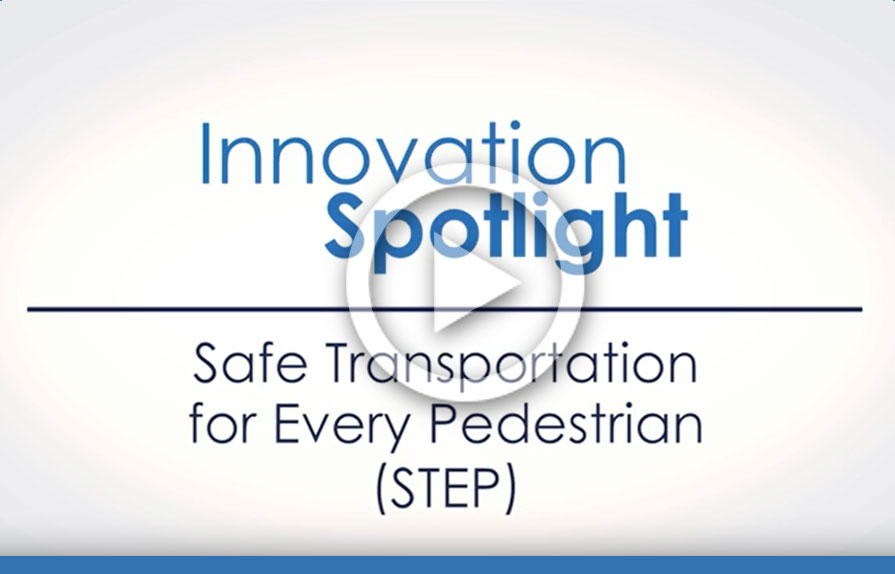June 7, 2018
Innovation of the Month:
Safe Transportation for Every Pedestrian
The Every Day Counts (EDC) innovation of the month for June is the Safe Transportation for Every Pedestrian (STEP) program, a set of cost-effective countermeasures that can enhance pedestrian safety and reduce fatalities at uncontrolled crossing locations.
About 72 percent of pedestrian fatalities occur at uncontrolled crossing locations, such as midblock areas and intersections with no signals or stop signs. The EDC deployment team offers training on the STEP countermeasures and helps State and local agencies implement policies, procedures, and proven engineering treatments to make uncontrolled crossing locations safer.
STEP focuses on five treatments to help pedestrians cross the road safely:
- Crosswalk visibility enhancements—including crosswalk lighting, enhanced signing and marking, and curb extensions—can reduce total crashes by 23 to 48 percent.
- Raised crosswalks are a traffic-calming technique that can reduce vehicle speeds, encourage drivers to yield to pedestrians, and lower pedestrian crashes by 45 percent.
- Pedestrian refuge islands provide a safer place for pedestrians to stop at the midpoint of a road before crossing the remaining distance, which can decrease pedestrian crashes by 32 percent.
- Pedestrian hybrid beacons (PHBs) provide a stop control treatment for higher speed multilane roads where pedestrian volumes aren’t high enough to warrant a traffic signal. PHBs can reduce pedestrian crashes by 55 percent.
- Road diets, which reconfigure a roadway cross-section to safely accommodate all users, can decrease vehicle speeds, reduce the number of lanes pedestrians must cross, and create space for new pedestrian facilities. Road diets can cut total crashes by 19 to 47 percent.
Read tech sheets on the STEP countermeasures.
View an Innovation Spotlight video on STEP.
Participate in an Institute of Transportation Engineers webinar on “The Past, Present, and Future of Pedestrian Crossing Research and Policy” on June 12 from 2 to 3:30 p.m. ET.
Contact Becky Crowe of the Federal Highway Administration Office of Safety or Peter Eun of the FHWA Resource Center for information and technical assistance.
Florida Agencies Explore Pavement Preservation Strategies
FHWA partnered with the Florida Department of Transportation on two workshops for local agencies on pavement preservation (when, where, and how). The workshops focused on the use of pavement preservation as a cost-effective way to sustain infrastructure through whole-life investments. After learning how to evaluate the impact of pavement of preservation on their pavement management systems, attendees participated in exercises to identify the cause of various pavement distresses and determine which preservation processes would best solve specific problems. They also discussed techniques for selecting preservation treatments to target existing distresses and proactively extend pavement life. For information on pavement preservation or to schedule a workshop, contact Jason Dietz of the FHWA Resource Center.
Missouri Demonstrates Intelligent Compaction on Paving Projects
The Missouri Department of Transportation (MoDOT) used Accelerated Innovation Deployment Demonstration funds to demonstrate the use of intelligent compaction (IC) and infrared scanning (IR) to improve pavement construction quality control and efficiency. MoDOT applied the technologies on 13 projects across the State to provide real-time detection of paving and compaction issues so crews could make any needed adjustments to the paving operation. Data from the projects show that using IC and IR improved construction quality, which can result in longer-lasting pavements and lower maintenance costs. MoDOT is using IC and IR on 14 more projects this year and plans full adoption of the technologies within 5 years. For details on the project, read MoDOT’s report or contact Bill Stone of MoDOT. For information on intelligent compaction, contact Michael Arasteh of the FHWA Resource Center.
About EDC
Every Day Counts, a State-based program of the Federal Highway Administration’s Center for Accelerating Innovation, works with State, local, and private sector partners to encourage the adoption of proven technologies and innovations to shorten and enhance project delivery.



